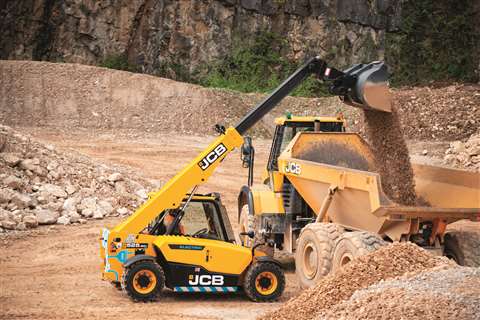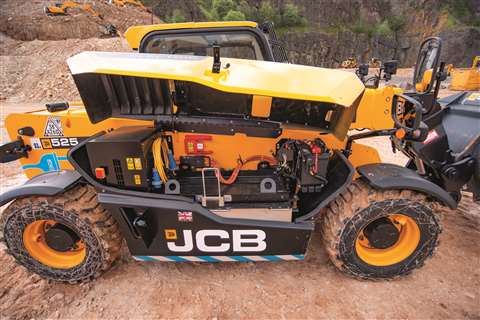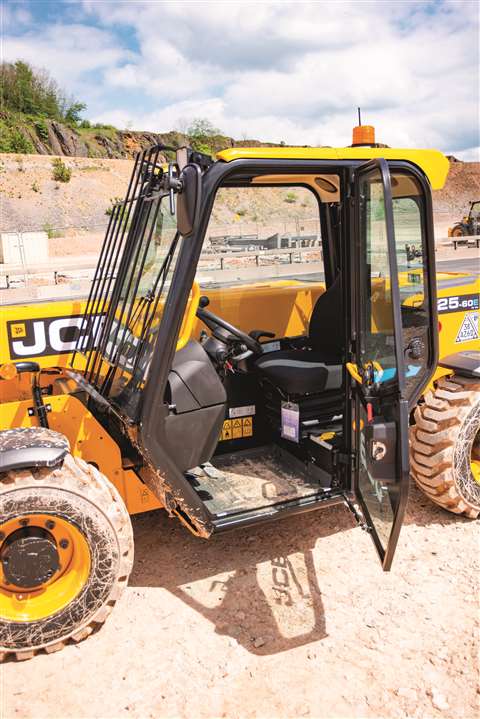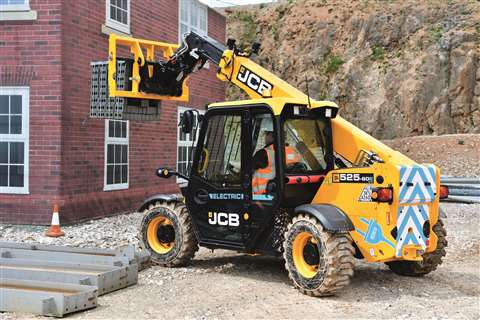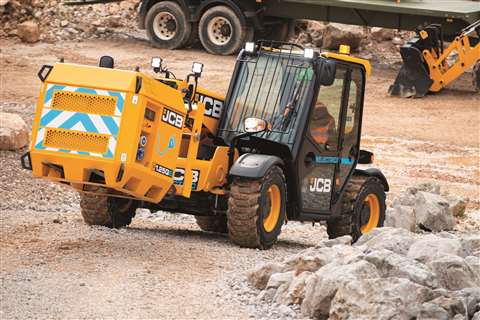
Test drive: JCB 525-60E telehandler
22 November 2021
Test drive: JCB 525-60E telehandler
In the first of a new ‘Test drive’ series for KHL, construction equipment journalist Dan Gilkes puts the JCB 525-60E electric telehandler under the microscope.
The electric revolution has begun. As many countries look to improve air quality by reducing engine emissions, the transport, logistics and construction machinery markets have been moving away from fossil fuel-based engines and drivelines.
The passenger car market has led the way and, in countries such as Norway, electric cars and vans now outsell petrol and diesel models.
Light commercial vehicles are following and even heavy trucks are being launched with electric and fuel cell drivelines.
The construction, agricultural and industrial sectors are no strangers to electric drive. There have been warehouse forklifts running on heavy lead acid batteries for years, while the access industry has pioneered electric platforms for indoor use.
Bringing electric drive to more conventional construction equipment has not been such a simple task though.
We’ve seen some hybrid drivelines, using a slewing excavator or a braking wheeled loader to recoup wasted electric energy, but having enough battery power for a full day on site has been harder to achieve.
JCB has taken a lead in electrification, offering a mini excavator, a mini site dumper, an industrial telescopic forklift and of course a full line of access platforms with battery power.
More recently, the company launched the 525-60E, a Loadall telescopic handler that, when diesel-powered, is equally at home on construction sites and in agriculture.
As the name suggests, the 525-60E has a maximum lift capacity of 2.5 tonnes, while the maximum lift height is 6.0 m. The E denotes that it is part of the firm’s growing E-TECH line-up.
Other than being electrically powered, JCB’s intention is that the machine should be able to perform exactly the same as the diesel 525-60, with the same lift capacities and boom reach.
Under the hood of the JCB 525-60E Loadall
With the conventional engine and transmission removed, JCB has installed a 24kWh lithium-ion battery in the engine bay to the right of the chassis. This is supplied by industrial forklift manufacturer Jungheinrich and it runs a 96 V electric system.
The company’s research has shown that this provides the capacity to deliver a full day’s work for 90% of Loadall customers. There is also a conventional 12 V battery for ancillary functions.
A motor controller takes the DC charge from the main batteries and converts it to AC, which is sent to two separate electric motors.
A 17 kW traction motor drives through a four-wheel drive dropbox, to both of the JCB drive/steer axles, for permanent four-wheel drive.
These axles are similar to those on the diesel machine, but with reduced disc brake capacity, as the electric motor offers regenerative braking, which in turn recharges the battery. Having fewer discs also reduces drag on the motor, saving battery power.
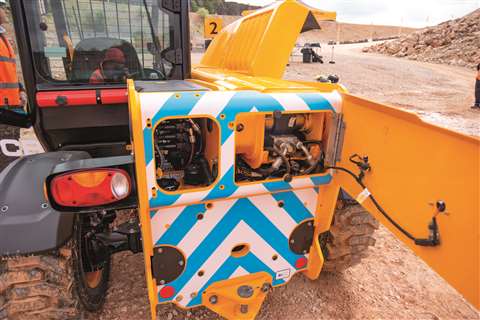
A second 22 kW electric motor powers the boom functions, through an 80 litre/min fixed displacement gear pump, which works independently of the traction drive system.
This makes it possible to lift and extend the boom while powering the wheels, which will appeal to those customers who work the Loadall with a bucket.
As the hydraulic pump is no longer attached to a diesel engine that is spinning all of the time, the drive to the pump is only activated when the operator calls for boom functions. This reduces the electrical energy required to power the hydraulic system.
In addition, the system regenerates flow as the boom is lowered, reducing the energy required to power the hydraulics, though this doesn’t create electrical charge for the battery.
The 525-60E has the same electro-hydraulic valve block as the diesel model and an identical servo lever in the cab, making it an easy transition for operators and hire companies.
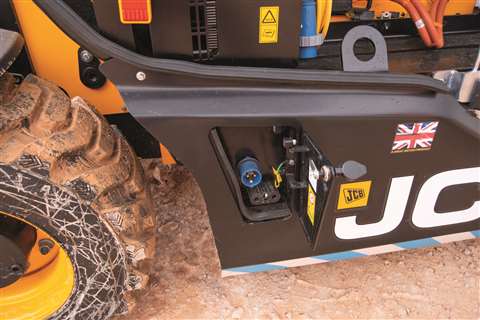
How long does it take to charge an electric telehandler?
The machine is equipped with a 3kW on-board charger that is capable of fully charging the battery in 8 hours, using a domestic 230/240 V electrical supply.
JCB has not opted to use the dedicated charging plugs and cables found on electric cars, as there will be few construction sites with car charging points.
Instead, you will find a typical blue site connector in the small charging port ahead of the right-hand rear wheel.
JCB also offers an optional Universal Charger point, that can cope with far higher inputs. Using 18 kW rapid charging, the machine can achieve a full charge from zero in just 110 minutes.
If you have access to 27 kW supercharging inputs, then the battery can be taken from empty to 100% charged in just 60 minutes, while a 25-80% top-up can be carried out in just 35 minutes, or within a typical lunch break.
For sites where access to mains electricity is not conveniently available, JCB also offers a range of power packs, that can be charged away from the working area and then used to recharge electrical equipment over night.
Inside the JCB cab
Unsurprisingly, the cab is unchanged from the diesel model, other than some slightly different graphics in the main console, where engine rpm has been replaced by a battery symbol to show remaining charge.
Despite its compact dimensions, at just 1.89 m high without beacons it is possible to drive the 525-60E into an underground car park, the machine has a full ROPS/FOPS cab.
The fully glazed cab has a 2.2 kW electric heater, along with heated front, side and rear screens for rapid defrosting in the mornings.
There is also a heated suspension seat, ensuring a comfortable working environment whatever the weather, while the machine is equipped with JCB’s Adaptive Load Control System with A-pillar mounted screen, for maximum lift safety.
Visibility from the driver’s seat is very good, as the move from diesel to electric drive has not resulted in any additional bodywork to block the view.
Indeed, had JCB wanted to, it could have reduced the old engine cover to further boost vision across the machine, as the battery and motor controller are smaller than the diesel engine and transmission that they replace.
Noise levels
While the JCB 525-60E’s performance and productivity is on a par with the diesel model, one thing has been reduced, the noise that it creates.
In the cab, noise levels are just 66.7 dB, while externally the machine creates 92.2 dB, much of which comes from the hydraulic system.
Indeed, a white noise reversing alarm is an option that many buyers will probably want to take up, to warn other site users that the machine is in use.
What is it like to drive the JCB electric telehandler?
As with any electric vehicle, maximum torque is available from standstill, which gives the compact Loadall instant acceleration if required.
However, it is easy to smoothly creep forward while placing a load or getting forks under a pallet, as the drive pedal has reasonable feedback.
While there is a foot brake in the cab, the operator hardly ever needs to use it, as lifting off the drive pedal instantly results in regenerative braking.
This in effect means that the machine offers a single-pedal driving experience.
The 525-60E can be used with pallet forks, or with any of the attachments that are offered for the diesel model.
When equipped with a bucket, that instant torque build-up makes it easy to dig into a pile of material and get a full load.
As well as the maximum 2.5 tonne lift capacity, the machine offers a 2.0 tonne capacity at full height and a 720 kg lift capacity at its maximum 3.5 m forward reach.
The cost of owning an electric telehandler
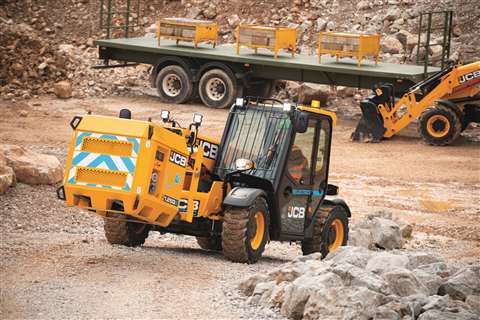
JCB freely admits that the 525-60E has a higher initial cost than the diesel model, that’s the same for any electric vehicle.
However, depending on how you get your charge, running costs should be considerably lower.
In addition, service requirements are greatly reduced, as there is no engine oil, no engine filters and far less use of the service brake.
The batteries are maintenance-free and there are minimal daily checks, so operators can get going more quickly at the start of the shift.
There are also plenty of sites where a lack of engine emissions, and to a lesser extent noise, will be very welcome. Working in an underground operation, or a car park for instance, will be possible without any need for costly exhaust extraction equipment.
Urban sites will also welcome the lack of noise and fumes, which could permit longer working hours in residential areas.
The Loadall can be supplied with the JCB LiveLink telematic system, providing fleet managers with real-time operating data, including battery charge levels and charging times.
LiveLink also offers location information, service requirement reminders and remote diagnostics capabilities.
Electric vs. diesel telehandler: is it as good?
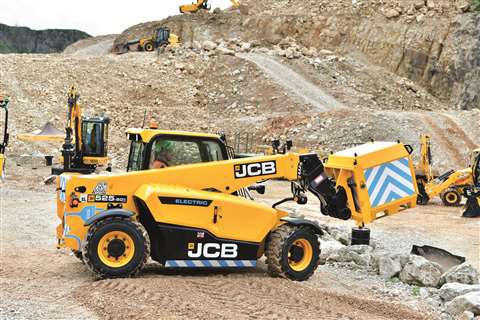
In short, yes. The 525-60E Loadall is a highly capable telehandler that loses nothing to its diesel counterpart in daily operation.
It can lift just as much, to the same height, and will do so without any exhaust emissions and with far lower noise levels.
It’s probably worth remembering as well, that this is JCB’s first shot at an electric Loadall.
The company said that it used the 525-60 as a base, as it was the ideal first model to have a zero-emission option, working across various construction and agricultural sectors.
However, as we move to the next generation of machines, we may see new packaging options that take that concept even further forwards.
About the author

Dan Gilkes is a freelance magazine editor and photographer, working in the construction equipment and commercial vehicle markets.
A plant and equipment engineer by training, he initially worked in opencast mining, civil engineering and plant hire, before becoming an equipment journalist. He has been a well-known plant and machinery editor for more than 30 years.
STAY CONNECTED



Receive the information you need when you need it through our world-leading magazines, newsletters and daily briefings.
CONNECT WITH THE TEAM








